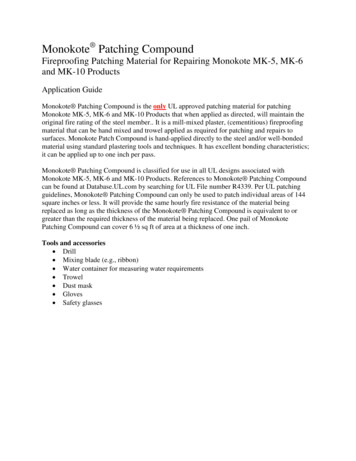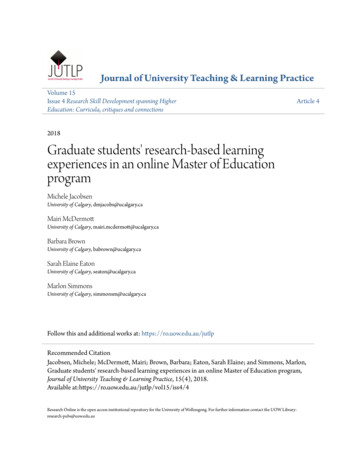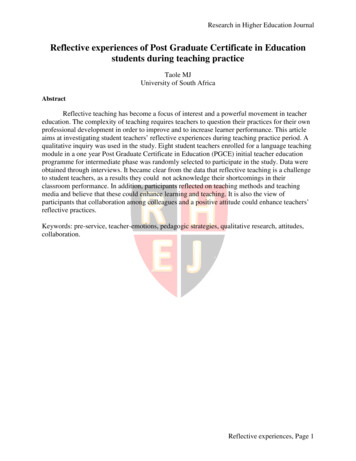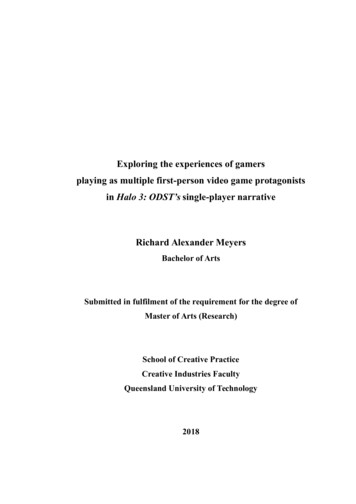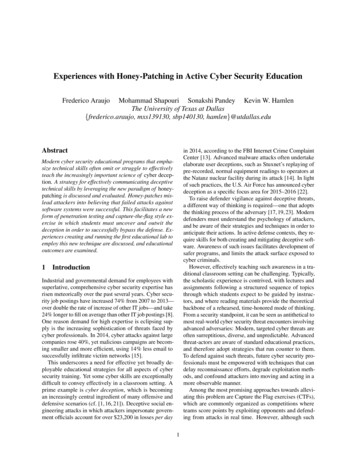
Transcription
Experiences with Honey-Patching in Active Cyber Security EducationFrederico AraujoMohammad Shapouri Sonakshi Pandey Kevin W. HamlenThe University of Texas at Dallas{frederico.araujo, mxs139130, sbp140130, hamlen}@utdallas.eduAbstractin 2014, according to the FBI Internet Crime ComplaintCenter [13]. Advanced malware attacks often undertakeelaborate user deceptions, such as Stuxnet’s replaying ofpre-recorded, normal equipment readings to operators atthe Natanz nuclear facility during its attack [14]. In lightof such practices, the U.S. Air Force has announced cyberdeception as a specific focus area for 2015–2016 [22].To raise defender vigilance against deceptive threats,a different way of thinking is required—one that adoptsthe thinking process of the adversary [17, 19, 23]. Moderndefenders must understand the psychology of attackers,and be aware of their strategies and techniques in order toanticipate their actions. In active defense contexts, they require skills for both creating and mitigating deceptive software. Awareness of such issues facilitates development ofsafer programs, and limits the attack surface exposed tocyber criminals.However, effectively teaching such awareness in a traditional classroom setting can be challenging. Typically,the scholastic experience is contrived, with lectures andassignments following a structured sequence of topicsthrough which students expect to be guided by instructors, and where reading materials provide the theoreticalbackbone of a rehearsed, time-honored mode of thinking.From a security standpoint, it can be seen as antithetical tomost real-world cyber security threat encounters involvingadvanced adversaries: Modern, targeted cyber threats areoften surreptitious, diverse, and unpredictable. Advancedthreat-actors are aware of standard educational practices,and therefore adopt strategies that run counter to them.To defend against such threats, future cyber security professionals must be empowered with techniques that candelay reconnaissance efforts, degrade exploitation methods, and confound attackers into moving and acting in amore observable manner.Among the most promising approaches towards alleviating this problem are Capture the Flag exercises (CTFs),which are commonly organized as competitions whereteams score points by exploiting opponents and defending from attacks in real time. However, although suchModern cyber security educational programs that emphasize technical skills often omit or struggle to effectivelyteach the increasingly important science of cyber deception. A strategy for effectively communicating deceptivetechnical skills by leveraging the new paradigm of honeypatching is discussed and evaluated. Honey-patches mislead attackers into believing that failed attacks againstsoftware systems were successful. This facilitates a newform of penetration testing and capture-the-flag style exercise in which students must uncover and outwit thedeception in order to successfully bypass the defense. Experiences creating and running the first educational lab toemploy this new technique are discussed, and educationaloutcomes are examined.1IntroductionIndustrial and governmental demand for employees withsuperlative, comprehensive cyber security expertise hasrisen meteorically over the past several years. Cyber security job postings have increased 74% from 2007 to 2013—over double the rate of increase of other IT jobs—and take24% longer to fill on average than other IT job postings [8].One reason demand for high expertise is eclipsing supply is the increasing sophistication of threats faced bycyber professionals. In 2014, cyber attacks against largecompanies rose 40%, yet malicious campaigns are becoming smaller and more efficient, using 14% less email tosuccessfully infiltrate victim networks [15].This underscores a need for effective yet broadly deployable educational strategies for all aspects of cybersecurity training. Yet some cyber skills are exceptionallydifficult to convey effectively in a classroom setting. Aprime example is cyber deception, which is becomingan increasingly central ingredient of many offensive anddefensive scenarios (cf. [1, 16, 21]). Deceptive social engineering attacks in which attackers impersonate government officials account for over 23,200 in losses per day1
exercises are of great educational value in that they offerlessons not easily taught in a classroom and provide arealistic, safe environment for practicing offensive techniques, they often lack emphasis on active cyber defensetopics (cf. [12]). We believe that ways must be sought toethically teach students deception and anti-deception techniques in order to make networks more resilient againstthe emerging wave of advanced threats.Toward this end, we have been examining honeypatching [2,3] as a new tool for effectively teaching activedefense and attacker-deception to students in the Computer Science Department at The University of Texas atDallas (UTD). Honey-patching is a recent technique developed to deceive, misdirect, and disinform attackers bydeceptively portraying the outcome of blocked attacksto attackers. Specifically, honey-patches are softwaresecurity patches that fix newly discovered software vulnerabilities in such a way that future attempted exploitsof the patched vulnerabilities appear successful to attackers. This masks patching lapses, impeding attackers fromeasily discerning which systems are genuinely vulnerableand which are actually patched systems masquerading asunpatched systems. It also affords defenders tremendousopportunities to gather information about the threat (e.g.,collecting and analyzing previously unseen malware, forpossible attack attribution), feed disinformation to the attacker in the form of falsified honey-data (cf., [6, 20, 24]),and even deploy counterattack measures to strike back atattackers.In April of 2015 we organized a small-scale computerlab at UTD to raise awareness about this technique and thebroader concepts surrounding cyber deception and antideception. The lab was organized with the help of UTD’sComputer Security Group (CSG) student association, constituting the first effort to teach honey-patching techniquesand strategies outside a research setting. Although smallin its size (seven students completed the lab session), theresponse we obtained from the participants of this earlytest were extremely positive. Our goal is to relate ourexperiences to other educators, and to recommend methods and software tools that we have found pedagogicallyeffective for teaching students these important skills. Wealso plan to leverage this initial experience to contributelarger-scale CTF exercises to major competitions in the future, such as TexSAW (Texas Security Awareness Week),which is held annually at UTD every October.The research reported herein is covered by UTD IRBapproval MR15-185. The educational lab and subsequentdata analysis were conducted by personnel who are NIHcertified in protection of human research subjects. The labwas organized and overseen by student officers trained inrisk management, including ethical and nondiscriminatorytreatment of individuals.server applicationhoney-patchedrequest reverse proxytriggercontrollerattackertargetcloneserver applicationresponseunpatched clonedecoycontainer poolFigure 1: Architectural overview of honey-patching.2Honey-PatchingPatching continues to be the most ubiquitous and widelyaccepted means for addressing newly discovered security vulnerabilities in commodity software products. In2014 alone, major software vendors reported over 7000patched (or soon-to-be-patched) separate security vulnerabilities to the National Vulnerability Database, almost25% of which were ranked highest severity [9]. However,despite the increasingly prompt availability of securitypatches, a majority of attacks in the wild continue to exploit vulnerabilities that are known and for which a patchexists [4, 5, 11]. This is in part because patch adoption isnot immediate, and may be slowed by various considerations, such as patch compatibility testing, in some sectors.As a result, determined, resourceful attackers oftenprobe and exploit unpatched, patchable vulnerabilities intheir victims. For example, a 2013 security audit of theU.S. Department of Energy revealed that 60% of DoEdesktops lacked critical patch updates, leading to a compromise and exfiltration of private information on over100,000 individuals [10]. The prevalence of unpatchedsystems has driven the proliferation of tools and technologies via which attackers quickly derive unique, previouslyunseen exploits from patches [7], allowing them to infiltrate vulnerable systems.Attackers are too often successful at finding and exploiting patching lapses because conventional softwaresecurity patches advertise rather than conceal such lapses.For example, a request that yields garbage output from anunpatched server, but that yields an error message froma patched server, readily divulges whether each serveris vulnerable. Cyber criminals therefore quickly and efficiently probe large networks for vulnerable software,focusing their attacks on susceptible targets.To counter this weakness, honey-patching, depictedin Figure 1, has been recently proposed as an effectivemeans of adding deceptiveness to software patches. Inresponse to malicious inputs, honey-patched applicationsclone the attacker session onto a confined, ephemeral,decoy environment, which behaves henceforth as an unpatched, vulnerable version of the software. This potentially augments the server with an embedded honeypot2
Listing 1: Abbreviate patch for CVE-2014-62711234567 if ((flags & SEVAL FUNCDEF) && command- type ! cm function def) { internal warning (”%s: ignoring function definition attempt”, .); should jump to top level 0; last result last command exit value EX BADUSAGE; break; }1:05 PM - 1:25 PM1:25 PM - 2:00 PMPreparationExploitation2:10 PM - 2:50 PMSurveyActive Defense1:00 PMFeedback3:00 PMFigure 2: Lab timeline and overview.Listing 2: Honey-patch for CVE-2014-6271the original container is safely terminated (having beenforked to the decoy), and legitimate, concurrent connections continue unaffected.As a result, adversaries attempting to exploit Shellshockin a victim server that has been honey-patched receiveserver responses that seem to indicate that the exploit hassucceeded. However, the shell commands they inject areactually executing in a decoy environment stocked withdisinformation for attackers to explore. This providesan ideal environment for students to penetrate as part ofexercises focused on cyber deception. Some of their attacks may genuinely hijack the victim server (e.g., thosethat exploit unpatched vulnerabilities), others observablyfail (e.g., those that exploit patched vulnerabilities), whileyet others only appear to succeed (e.g., those that exploithoney-patched vulnerabilities). The challenge is to discover that a deceptive outcome exists and counter it.1if ((flags & SEVAL FUNCDEF) && command- type ! cm function def)2{3 hp fork();4 hp skip(5internal warning (”%s: ignoring function definition attempt”, .);6should jump to top level 0;7last result last command exit value EX BADUSAGE;8break;9 );10}that waylays, monitors, and disinforms criminals. Deceptive honey-patching capabilities thereby constitute anadvanced, active defense technique that can impede, confound, and misdirect such attacks, and significantly raiseattacker risk and uncertainty.Honey-patching Shellshock. In September 2014 wehoney-patched the Shellshock GNU Bash remote command execution vulnerability (CVE-2014-6271) [18]within hours of its public disclosure as part of ourAFOSR/NSF active defense and attack-attribution research program. Shellshock was one of the most severevulnerabilities in recent history, affecting millions of thendeployed web servers and other Internet-connected devices. This high impact combined with its ease of exploitation makes it a prime candidate for penetration testingexercises.Listing 1 shows an abbreviated, vendor-released patchin diff style for Shellshock. The patch introduces a conditional that validates environment variables passed to Bash,declining function definition attempts. Prior to this patch,attackers could take advantage of HTTP headers as wellas other mechanisms to enable unauthorized access to theunderlying system shell of remote targets. This patch exemplifies a common vulnerability mitigation: dangerousinputs or program states are detected via a boolean test,with positive detection eliciting a corrective action. Thecorrective action is typically readily distinguishable byattackers—in this case, a warning message is generatedand the function definition is ignored.Listing 2 presents an alternative, honey-patched implementation of the same patch. In response to a maliciousinput, the honey-patched application forks itself onto aconfined, ephemeral, decoy environment, and behaveshenceforth as an unpatched, vulnerable version of thesoftware. Specifically, line 3 forks the user session to adecoy container, and macro hp skip in line 4 elides therejection in the decoy container so that the attack appearsto have succeeded. Meanwhile, the attacker session in3Lab OverviewWe organized an open lab with the main goal of educatingstudents on offensive security and active cyber defenseconcepts using honey-patching as the underlying framework. To boost students expectation and interest, weselected the Shellshock [18] vulnerability as our unit ofstudy. This choice was motivated by the scale and impactof Shellshock (severity 10 out of 10), and the low accesscomplexity of the attack, suitable for the two hours allotted for the lab. Figure 2 shows the lab timeline with theapproximate durations of each of its three parts.Preparation. The first part provided an overview of thelab session, followed by a brief introduction to Shellshock.As part of this description, we covered the historical background and relevancy of Bash, and detailed the various attack vectors that can be used to exploit server applicationsrunning the vulnerable shell. In addition, we introducedbasic background on our particular target server deployment (e.g., Apache, CGI). At the end of this exposition,we ran an interactive demonstration of Shellshock to teststudents’ understanding of the vulnerability and ensurethat they were familiarized with the lab environment.Exploitation challenge. The hands-on part of the labconsisted of a challenge. Students were asked to attackour server and attempt to escalate their privileges aftergaining access to the server. To complete this exercise,3
students needed to build their own exploits and apply theknowledge acquired in the preparation session of the lab.At the end of this exercise, we asked students to fill outan online survey. In order to obtain an unbiased feedback,students were unaware that they were attacking a honeypatched system. We only revealed this information in thethird and last part of the lab.Listing 3: Decoy’s file-system monitoring1234You CREATEYou OPENYou ATTRIBYou CLOSE.0x0020:0x0030:0x0040:0x0050:0x0060:8018 00e5 1aed 0000 0101 080a 0032 9a09 .2.0032 9a09 3261 0d0a 495f 5368 6f63 6b65 .2.2a.I Shocke645f 596f 750a 6c6f 6769 6e2e 6367 690a d You.login.cgi.6d69 6e65 0a6e 6f5f 796f 755f 6469 646e mine.no you didn740a 0d0at.concealed within the system. For example, participantsmight transfer the encrypted password file to their ownmachines, and crack it with a password cracker (e.g., using a dictionary attack).Monitoring. Decoys also hosted software monitors thatcollected fine-grained attack information. To minimizethe performance impact on decoys, we used two powerfuland highly efficient tools: inotifywait (to track modifications made to the file system), and tcpdump (to monitoringress and egress of network packets). To avoid possibletampering with the collected data, all logs were storedoutside the decoy environments. In addition, we tunedboth monitoring tools to avoid generating spurious outputs (e.g., by excluding certain directories and limitingthe monitored network traffic). Listings 3 and 4 showsample monitoring logs produced after an attack executedby a student. The logged file system events reveal thatthe student created a file named I Shocked You in theserver’s (actually, a decoy’s) CGI directory and changedthe created file’s permissions. In the network logs, we seethe response payload returned to the student for an attackthat ran the ls command on the server.Lab DesignFrom the provisioning of the required physical resourcesand setup of the lab environment to the preparation oftutorials and challenges, there is a considerable amountof effort involved in organizing a hands-on cyber securitylab. Even though the number of students was small, wedesigned this exercise to scale to a much larger numberof participants. In what follows, we highlight some of thepreparation steps for this lab.4.1ShockedShockedShockedShockedListing 4: Decoy’s deep inspection of network packets12345Deception-based active defense. In the last part of thelab, we first provided a brief overview of deception-basedtechniques for active defense and offensive countermeasure concepts (e.g., honeypots, decoys, beacons). Thenwe introduced students to honey-patching and disclosedthe fact that our target server was honey-patched, explaining its underlying mechanisms, including misdirectionand monitoring capabilities. We also demonstrated theprocess involved in honey-patching Shellshock. To conclude the exercise, we gave students the opportunity toattack the system once again, for another 30 minutes, andthen presented and discussed the monitoring logs generated by the honey-patched system. Before we adjourned,we asked students to fill out a second survey providingfeedback about their learning experience.425/04/2015 13:24:25 /usr/local/apache/cgi bin/ I25/04/2015 13:24:25 /usr/local/apache/cgi bin/ I25/04/2015 13:24:25 /usr/local/apache/cgi bin/ I25/04/2015 13:24:25 /usr/local/apache/cgi bin/ IAttacker environment. Each student was assigned aguest VM prepared specifically for the hands-on exercises.Each VM ran Ubuntu 14.04, and came with the minimaltools required to complete the demonstration session (i.e.,curl, nc). Student accounts were configured with administrative privileges, and internet access was not prohibited,allowing easy installation of additional tools as needed.For example, several students downloaded and installedpassword crackers to use during the hands-on session.Infrastructure & PreparationFigure 3a illustrates the infrastructure created for the lab.We built this infrastructure atop VMWare’s ESXi, allowing us to quickly and efficiently deploy many linked VMsas needed to create individual guest environments for eachparticipant. The target server and attacker VMs were deployed within the same subnet, and access control rulesisolated the lab from the rest of the university network.This created a safe environment in which exploits couldbe attempted without risk to the surrounding network.4.2Target server. The target server was honey-patchedagainst Shellshock and hosted a CGI shell script deployedatop Apache for processing user authentication in a webapplication specifically created for this lab. To entice students to further exploit the system, decoys were generatedwith fake user accounts and honey-files containing “interesting” information, such as fake credentials and weaklyencrypted user account passwords. To gain escalated access to the decoy, students could discover vulnerable pathsInteractive DemonstrationThe demonstration delivered at the end of the preparation session consisted of a no-one-left-behind exercise,in which the instructor explains each step of the demoand waits until all students have successfully completedit. This strategy worked well given our small group, butwould probably need to be adjusted for a larger numberof students (e.g., by hav
Experiences with Honey-Patching in Active Cyber Security Education Frederico Araujo Mohammad Shapouri Sonakshi Pandey Kevin W. Hamlen The University of Texas at Dallas ffrederico.araujo, mxs139130, sbp140130, hamleng@utdallas.edu Abstract Modern cyber security educational programs that
